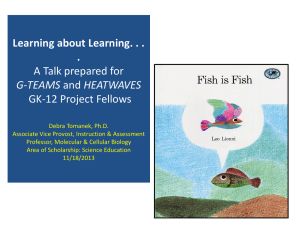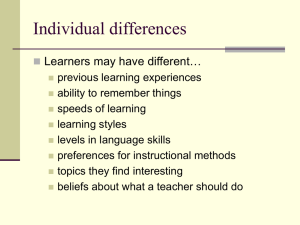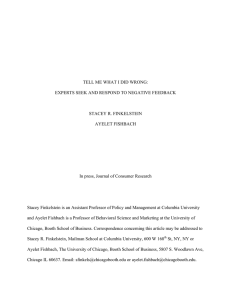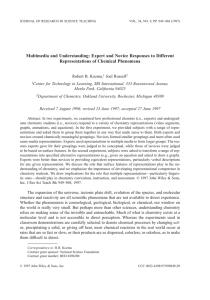Experts vs Novices: What Students Struggle with Most in STEM
advertisement
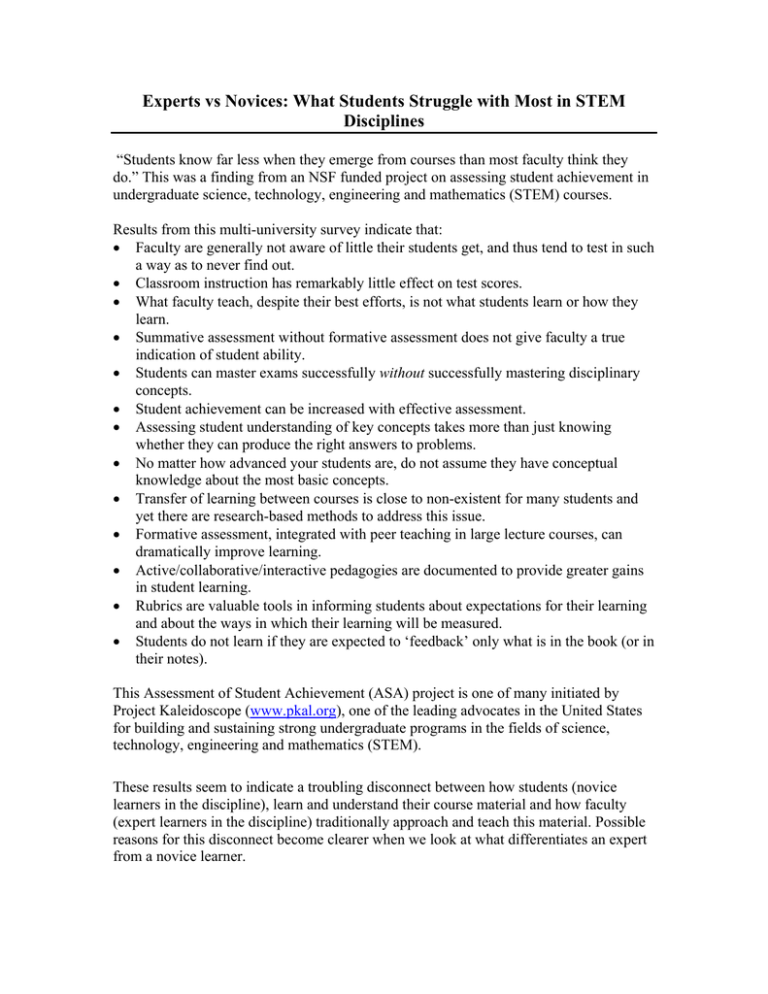
Experts vs Novices: What Students Struggle with Most in STEM Disciplines “Students know far less when they emerge from courses than most faculty think they do.” This was a finding from an NSF funded project on assessing student achievement in undergraduate science, technology, engineering and mathematics (STEM) courses. Results from this multi-university survey indicate that: • Faculty are generally not aware of little their students get, and thus tend to test in such a way as to never find out. • Classroom instruction has remarkably little effect on test scores. • What faculty teach, despite their best efforts, is not what students learn or how they learn. • Summative assessment without formative assessment does not give faculty a true indication of student ability. • Students can master exams successfully without successfully mastering disciplinary concepts. • Student achievement can be increased with effective assessment. • Assessing student understanding of key concepts takes more than just knowing whether they can produce the right answers to problems. • No matter how advanced your students are, do not assume they have conceptual knowledge about the most basic concepts. • Transfer of learning between courses is close to non-existent for many students and yet there are research-based methods to address this issue. • Formative assessment, integrated with peer teaching in large lecture courses, can dramatically improve learning. • Active/collaborative/interactive pedagogies are documented to provide greater gains in student learning. • Rubrics are valuable tools in informing students about expectations for their learning and about the ways in which their learning will be measured. • Students do not learn if they are expected to ‘feedback’ only what is in the book (or in their notes). This Assessment of Student Achievement (ASA) project is one of many initiated by Project Kaleidoscope (www.pkal.org), one of the leading advocates in the United States for building and sustaining strong undergraduate programs in the fields of science, technology, engineering and mathematics (STEM). These results seem to indicate a troubling disconnect between how students (novice learners in the discipline), learn and understand their course material and how faculty (expert learners in the discipline) traditionally approach and teach this material. Possible reasons for this disconnect become clearer when we look at what differentiates an expert from a novice learner. What differentiates an ‘expert’ from a ‘novice’? An expert is someone who has a high degree of proficiency, skill, and knowledge in a particular subject. Experts are able to effectively think about and solve problems. They see patterns in information and are able to identify solutions. Moving from novice to expert involves much more than simply developing a set of generic skills and strategies. Experts develop extensive knowledge that impacts the way they identify problems, organize and interpret data, and formulate solutions. Their approach to reasoning and solving problems is different from that of a novice. In their report, How People Learn: Brain, Mind, Experience, and School (http://www.nap.edu/html/howpeople1/), Bransford et. al. (1999) identified key principles of experts' knowledge and their potential implications for learning and instruction: • • • • • • Experts notice features and meaningful patterns of information that are not noticed by novices. Experts have acquired a great deal of content knowledge that is organized in ways that reflect a deep understanding of their subject matter. Experts' knowledge cannot be reduced to sets of isolated facts or propositions but, instead, reflects contexts of applicability: that is, the knowledge is "conditionalized" on a set of circumstances. Experts are able to flexibly retrieve important aspects of their knowledge with little attentional effort. Though experts know their disciplines thoroughly, this does not guarantee that they are able to teach others. Experts have varying levels of flexibility in their approach to new situations. Based on the growing body of research, the following attributes of experts can be identified. Experts: • • • • • • • • Pose useful questions to themselves about the information they are exploring. Identify relevant information and ignore irrelevant information. Respond to context and select information to address specific needs. Recognize meaningful patterns and connections in information Organize knowledge around key principles and concepts. Self-regulate their time and efforts including goal setting, time management, selfevaluation, self-motivation. Self-motivate through varying their methods of study and practice. Remain flexible in thinking, adapting to changing needs. So, how can faculty/experts help students develop the necessary repertoire of knowledge and range of skills and strategies? Consider some of the following key areas: • • • • • Core Concepts and Experiences - learners need a foundation of knowledge, background information, examples, resources, and varied experiences related to their topic organized around the big ideas Task Analysis - learners must develop an understanding of the problem or key questions and be able to prioritize and focus on the key issues Pattern Recognition - learners must be able to structure information in meaningful ways and see the how ideas are connected Metacognition - learners must be aware of their thinking and flexible enough to adapt to changing needs Self-regulation - learners must be able to control their thinking and actions Content adapted from virtualinquiry.com (http://virtualinquiry.com/scientist/scientist1a.htm) Selected expert-novice differences in problem-solving: 1. Experts classify problems based on deep structure, while novices classify based on surface features. Experts/faculty have a cognitive map of their discipline and tend to grasp the ‘big picture’ easily. Students want to know formulas and equations (”why do I have to know this?”) and want to get it right rather than understand the purpose of the question/problem. 1. Chi, M.T.H., Feltovich, P., Glaser, R. 1981. Categorization and representation of physics problems by experts and novices. Cognitive Science 5(2):121-152. 2. Sweller, J. 1988. Cognitive load during problem solving: effects on learning. Cognitive Science 12(2): 257-285. 2. Expert knowledge is chunked and organized hierarchically (around basic principles), while novice knowledge is more randomly organized (they don’t have the expertise to connect new information they learn to something they already know). • Eylon, B and Reif, F. 1984. Effects of knowledge organization on task performance. Cognition and Instruction 1(1): 5-44. • Larkin, J.H. 1979. Processing information for effective problem solving. Engineering Education 70(3): 285-288. • Reif, F. 1981. Teaching problem solving – a scientific approach. The Physics Teacher 19(5): 310316. 3. Experts start with general equations, while novices start with specific equations. Novices tend to use a “means-to-an-end” approach, in other words, work backwards (the answer defines they way to solve or approach the problem), while experts work forward, checking logic and answers as they go. • Simon, D.P. and Simon, H.A. 1978. Individual differences in solving physics problems. In: Seigler, R.S. (ed), Children’s Thinking: What Develops? Lawrence Erlbaum Associates, Hillsdale, NJ. 4. Experts view problem-solving as a process, while novices think it is a recall task. By the time someone becomes an expert, something that may have been viewed as a “problem” at some point has generally become an “exercise”. Experts can make solving problems look easy, which causes novices to mistakenly think that they should be able to understand and solve problems easily too. When this does not translate in practice, novices generally become frustrated and question their ability. This is a problem that can push many students out of STEM disciplines because they feel they “just don’t get it and never will”. • Good., R. 1984. Scientific problem solving by expert systems. Journal of Research in Science Teaching 21(3): 331-340. • Whimbey, A. and Lochhead, J. 1980. Problem Solving and Comprehension – A Short Course in Analytical Reasoning. Franklin Institute Press, Philadelphia, PA. 5. Experts use qualitative representations extensively, while novices have trouble with representations. • Dufresne, R.J., Gerace, W.J., Leonard, W.J. 1997. Solving physics problems with multiple representations. The Physics Teacher 35(5): 270-275. • Van Heuvelen, A. 1991. Learning to think like a physicist: a review of research-based strategies. American Journal of Physics 59(10): 891-895. • Larkin, J.H. and Simon, A. 1995. Why a diagram is (sometimes) worth 10, 000 words. In Glasgow, J., Narayanan, H. and Chandraskaran, B. (eds). Diagrammatic Reasoning: Cognitive and Computational Perspectives. AAAI Press/MIT Press, Menlo Park, CA. Content adapted from: “Making Problem Solving a Priority” presented by Kathleen A. Harper, Department of Physics, Ohio State University at the 32nd Annual Conference of the Professional Organization and Development (POD) Network, October 2007, Pittsburgh, Pennsylvania, U.S.A..
